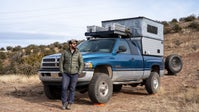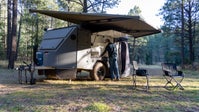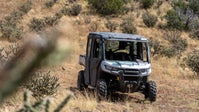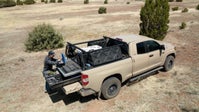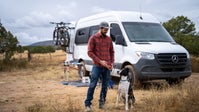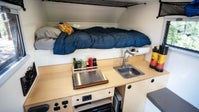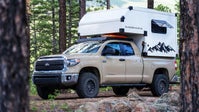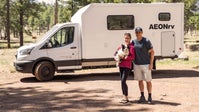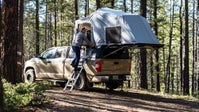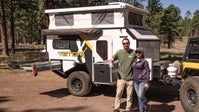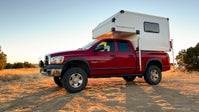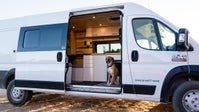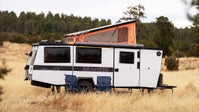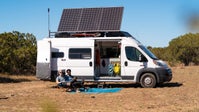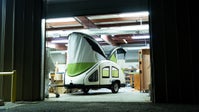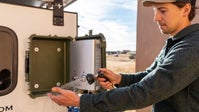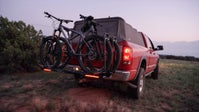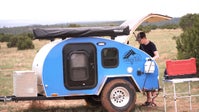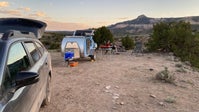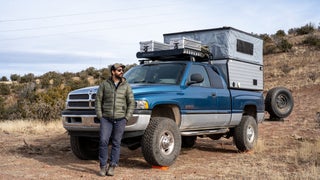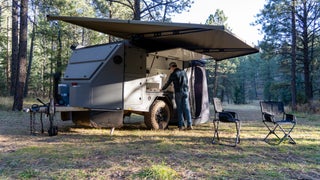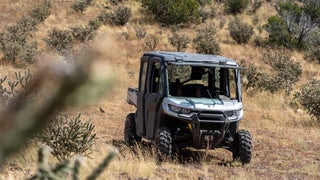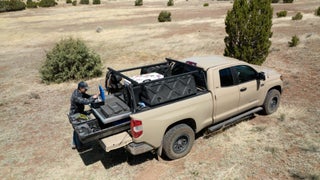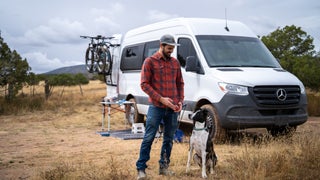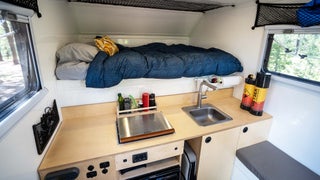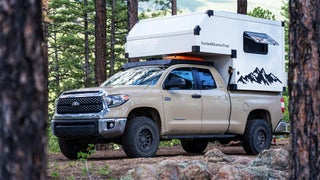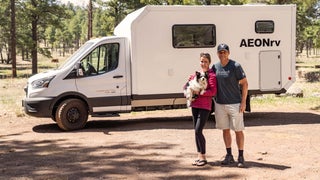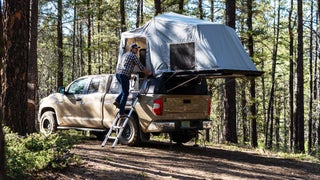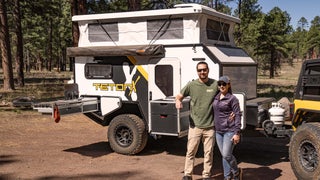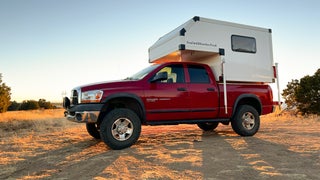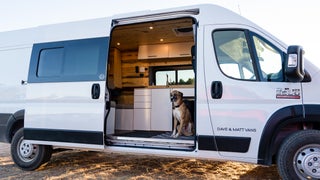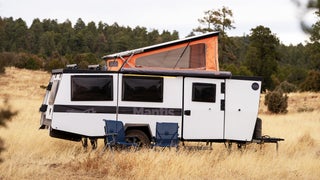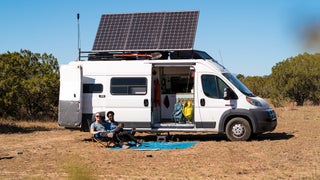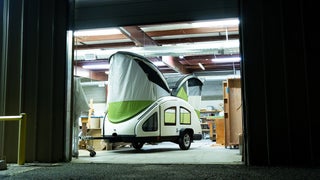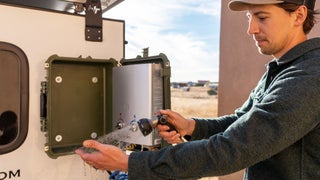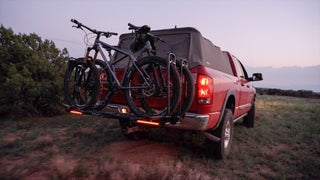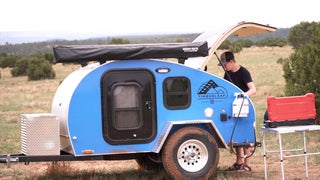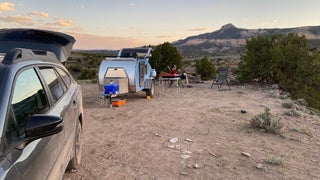[MUSIC PLAYING] DAN GREC: I built this because I wanted to go to remote places. But the goal wasn't to build a cool vehicle. The goal was to have a big adventure.
BRYAN ROGALA: Sure.
DAN GREC: Yeah. And the vehicle just enabled that.
BRYAN ROGALA: This series is all about adventure vehicles. To me, driving is not just about getting from point A to point B. It's about how you get there and what you find along the way.
And that is the whole point of a good adventure mobile. It's something that enables you to get outside more often and do the things you love.
Hey, everybody. Bryan Rogala here for ���ϳԹ���. This is The 101. Today, we are with Dan Grec.
Dan just got back from a three year journey. He drove his Jeep around Africa, which is not something that most people do. So we're going to get a tour of Dan's Jeep here, and kind of hear a little bit about the trip.
So first off, what made you decide to want to do this?
DAN GREC: I wanted to have adventure. I wanted to meet new people, try new foods, learn new languages. And I wanted to get as remote as possible on the planet.
BRYAN ROGALA: And so that meant Africa.
DAN GREC: Exactly. Yeah. The more research I did, the more I found that Africa was where I wanted to go.
BRYAN ROGALA: That's quite the trip.
DAN GREC: Yeah. And so it took three years, 54,000 miles, through 35 different countries in Africa.
BRYAN ROGALA: Wow.
DAN GREC: Yeah.
BRYAN ROGALA: All right. So this guy has done a lot of driving, basically.
DAN GREC: Well, I did-- I mean, I only drove 100 miles a day, on average. So actually, my goal is not to drive a lot, every day. It's to park the Jeep and get out and go for a walk in a street market, or go and buy vegetables, and then eat some street food and meet some people.
BRYAN ROGALA: And so a few years prior to that, I know you drove the Pan American Highway.
DAN GREC: That trip took two years. And I drove 40,000 miles.
BRYAN ROGALA: And that wasn't enough for you? You just decided you need more.
DAN GREC: Well, I said, either this is will be one and done, or I'll get addicted and this will be the rest of my life, having adventures like this.
BRYAN ROGALA: Tell us why you picked this Jeep. And what is it? It's a 2011 Jeep Wrangler?
DAN GREC: Right. This is a 2011 Jeep Wrangler Rubicon. It's the Unlimited. So it's the four door addition. It's longer, so I can sleep inside of it or on top of it.
And I chose a Jeep, Bryan, because they're so easy to get. Because anyone can go and buy one from a dealer. I bought mine used on Craigslist. And it's inexpensive. But you can take it anywhere on the whole planet and have these huge adventures.
It has completely stock engine, drive line, axles, drive shafts. All of that is from the factory and worked really well. So what I really focused on is all of the living systems and my creature comforts.
BRYAN ROGALA: All right. So let's start up at the front of the Jeep here. Tell me what you've got going on and some of the modifications you did to this thing.
DAN GREC: Right. Yeah, the first thing you're going to see is the front bumper. And radiated protection-- really important. When you're in foreign countries, there's goats on the road. There's bad drivers.
BRYAN ROGALA: Sure.
DAN GREC: So you really don't want to crack a radiator. I went with just modest driving lights that are around. Because I think LED light bars, they look like they're from the future. And when you're in Africa, you don't want your vehicle to be all blingy and shiny. You want it just to blend in.
BRYAN ROGALA: Sure.
DAN GREC: And then also, because I'm traveling alone, I do have a winch there in the front bumper, to be able to pull myself out when I get stuck. Yeah, and I did use it a couple of times. And it was a must-have, for sure.
BRYAN ROGALA: OK. So what wheels and tires did you go with for your trip?
DAN GREC: Yeah. So people often think you need really big tires on a Wrangler. And I think that's a really bad idea. Because you just put so much more stress on all the drive line components. And that's how you end up breaking things.
So these are only 33 inch tires, hardly bigger than stock. These are Yokohamas. And then these wheels-- something people don't think about, as well. These are actually made out of steel, not aluminum. So these cannot crack. They cannot break. And even if they get damaged, while I was in Africa, you can just kick them back into shape with a sledgehammer, or find a guy on the side of the road who can weld them.
BRYAN ROGALA: You have some recovery gear back here. Walk me through your tool list here, and what you used.
DAN GREC: Right. I tried to keep the things on the outside of the vehicle to a minimum, just because I feel like, again, attract more attention, if you too much stuff. This is a 10 gallon extra gas tank. And so I used that a lot. I needed it.
And then there was some countries, too, where there were just shortages. And so you show up. And I say, oh, no. There's no fuel in the whole country. So that gets really interesting.
BRYAN ROGALA: Yeah, I bet.
DAN GREC: I've got a full sized shovel there, in the event I need to dig the Jeep out. And then over on this side, I've done the Maxtrax, which were brilliant in the sand when you get stuck. And then behind that, is a high lift jack, as well.
[MUSIC PLAYING]
BRYAN ROGALA: OK. So show us the inside here.
DAN GREC: Absolutely. Yeah, the inside's where it gets interesting. So the first thing I have here is my little kitchen setup. And I wanted to have an area where I could cook good food, so that I wasn't just eating ramen noodles or buying food every day.
BRYAN ROGALA: Yeah, that would get old for three years, I would imagine.
DAN GREC: It would get really old, really fast. Yeah. And so I've got all my utensils right here where I need them. It means I don't have to fish through all of my cabinets. They're just on hand.
And my little stove here is a Coleman stove. And it burns gasoline, the same as the Jeep.
BRYAN ROGALA: Oh, nice.
DAN GREC: Yeah. So whenever I'm filling up the Jeep, I can fill the container that I use for this. And it means I didn't have any trouble with propane bottles and fittings and all that kind of thing.
BRYAN ROGALA: That's great. Yeah, absolutely.
DAN GREC: I built these cabinets. I made them myself out of plywood. So they weren't expensive and they're not heavy. The idea was to keep all of my things organized, so they're not all just bouncing around and covered in dust, and to give me this ability to be inside like this.
You know, with the roof open, I can stand up right now. And it means it's what I learned on the Pan American Highway. Camping and living outside is really great, until it starts dumping rain, or until the mosquitoes are nightmarish. And then having this interior living space is where your sanity comes from.
One of the things that I designed and built underneath the Jeep is a 13 gallon drinking water tank. And then tucked away, is a 0.5 micron carbon filter and a UV treatment plant. So if we turn that tap on right now, it'll pump water through the filter, through the UV lamp. And we have running drinking water.
BRYAN ROGALA: OK, Dan. I'm going to come up in here with you. This is actually more room than I thought there would be.
DAN GREC: Considering it's a Jeep Wrangler, it's pretty impressive two guys can stand up and walk around in here.
BRYAN ROGALA: So this is the sleeping platform up here.
DAN GREC: That's right.
BRYAN ROGALA: And show me what happens here. Basically, this just pulls out.
DAN GREC: Right. Yeah, these planks of wood come into the middle on both sides. And then these are all the mattress sections here. And then so stack those out, and make the bed.
There was many nights where I'd be up here. And I could hear hippos walking around the Jeep.
BRYAN ROGALA: Wow.
DAN GREC: Hippos are enormous. And they're really dangerous. And so you hear them grunting and snorting and tearing up the grass. And so you could just look straight down and see them, straight out of this match.
BRYAN ROGALA: Wow.
DAN GREC: Yeah. It was always a really cool experience.
BRYAN ROGALA: Oh, man.
DAN GREC: Some nights, I would be lions roaring. And it just felt like you were safe, this was, somehow, magically a safe space.
BRYAN ROGALA: Sure.
DAN GREC: Yeah, compared to a ground tent down there, I think you'd feel pretty vulnerable.
BRYAN ROGALA: Did you have any other particularly bad days, or anything major that went wrong on the trip?
DAN GREC: The worst thing, actually, I thought I failed and the whole expedition was finished. I actually rolled the Jeep on its side in Uganda.
BRYAN ROGALA: Wow.
DAN GREC: Yeah. I was all by myself.
BRYAN ROGALA: Well, what did you do?
DAN GREC: I mean, I panicked. And I was emotionally overwrought. And in the end, some locals started showing up.
And so they pushed on the side of the Jeep. And I used the winch off a tree. And together, we got it back up onto the wheels.
BRYAN ROGALA: And it was fine?
DAN GREC: Yeah. I mean, the fenders were torn off. And there's some dents and scratches down the side. But I put some duct tape on it, had some guys weld the mirror back on for me, and I've been driving it ever since.
BRYAN ROGALA: What would you tell somebody who wants to go and do something solo like this, on an extended trip? What's your biggest piece of advice?
DAN GREC: I think keep it simple is really important. And I think be really conscious of not bringing more stuff than you need. And for one, you're just going to spend so much money on all the stuff. You're not going to have any money left to actually go and have an adventure.
And the reason to have the vehicle is to go on adventures. So gas in the tank has to be the priority. I always say, for every $50 I spent building this Jeep, that's one less day that I had in Africa.
You know, I could have put a big V8 in it. Or I could have supercharged it. I just made my trip shorter.
BRYAN ROGALA: Interesting.
DAN GREC: And I need to. I made it without any of those things.
You know, the Jeep I bought used, it with $17,000. It had 60,000 miles on it. And then I probably put a bit more than that into it, with all the accessories and things.
BRYAN ROGALA: Sure. Yeah.
DAN GREC: But you know, the Jeep and the entire three year expedition, it cost less than most Sprinters do, you know, a decked out, four-wheel drive Sprinter. $120,000 or $140,000, that's more than I spent on everything.
BRYAN ROGALA: That's incredible. Well, if you like this video, and you want to see more, make sure you subscribe to our YouTube channel.
You can follow Dan on his website, The Road Chose Me. He's on Instagram and YouTube and all the other places that you can find people.
DAN GREC: That's right.
BRYAN ROGALA: And otherwise, we'll see you next time.
